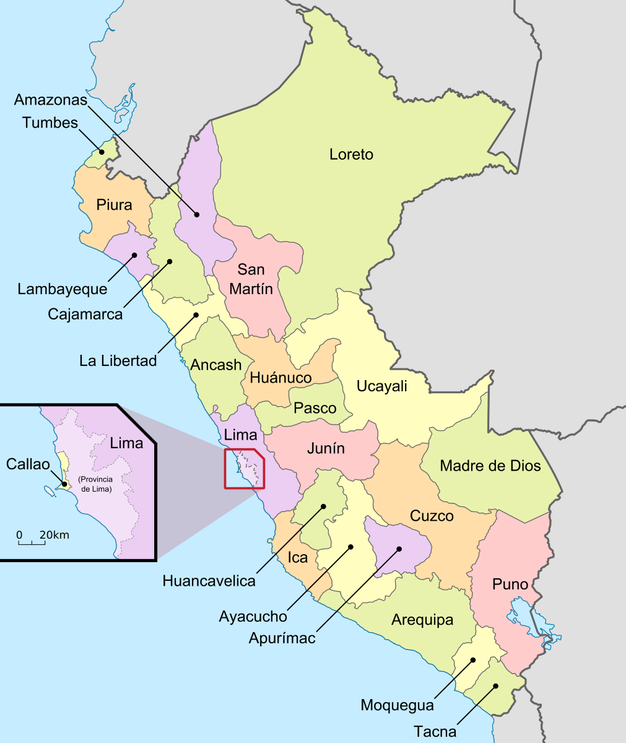Peru expects a 10% growth in agro-exports by 202 by FreshPlaza
Peru expects a 10% growth in agro-exports by 2025
Over the past two decades, Peru has firmly established itself as a major player in global agriculture. It now ranks among the world’s top exporters of products like asparagus, blueberries, avocados, and table grapes. This rapid growth has made agricultural exports the country’s second-largest source of income, after mining, and has significantly boosted employment, directly or indirectly involving nearly a quarter of the population.
Peru’s natural advantage: geographic and climatic diversity
One of Peru’s greatest strengths lies in its natural diversity. With up to 38 different climate types across its territory, Peru can grow crops year-round. This gives it a clear edge over other countries with more rigid seasonal cycles.

Geographically, Peru is divided into three regions: the Coast, the Highlands (Sierra), and the Jungle (Selva). The Coast, although mostly desert, is home to around 60% of the population—mainly in urban areas. Thanks to the large-scale use of modern irrigation systems, this region has developed a high-value agricultural sector. Here, export-oriented crops are grown, such as table grapes, avocados, mangoes, blueberries, asparagus, artichokes, onions, and peppers. However, northern and, to a lesser extent, central coastal areas are vulnerable to the El Niño coastal phenomenon, which periodically brings intense, and sometimes destructive, rains.
The Sierra, home to about 26% of Peruvians, is dominated by small-scale farmers who typically work plots smaller than five hectares. Their focus is mainly on the domestic market, growing traditional crops like potatoes, corn, quinoa, cabbage, carrots, and tomatoes. That said, more commercial crops such as avocados are also emerging in some Andean areas, along with pilot projects involving cherries.
The Selva (Jungle) makes up 60% of Peru’s land area but holds just 14% of its population. Subsistence farming is still common here, though in recent years, commercial production of coffee, cacao, bananas, ginger, and turmeric has expanded.
Farm structure and the challenges facing small growers
Many of Peru’s key export crops, avocados, mangoes, bananas, citrus fruits, asparagus, peppers, artichokes, onions, ginger, and turmeric, are to some extent grown by smallholders. This structure is partly the result of the agrarian reform of the 1970s and later land fragmentation through inheritance. As a result, minifundios (small plots) are common, especially in the Sierra and Selva, and in some parts of the Coast.
This fragmented landscape creates major challenges for efficient marketing: lack of organization, poor infrastructure, inconsistent standards, and limited access to technology. To overcome these barriers, various export companies are working to integrate small producers by providing training, supplying inputs, and coordinating production volumes.
In contrast, crops like table grapes and blueberries are mostly grown on large estates managed by agro-industrial firms. These operations benefit from economies of scale, meet international phytosanitary standards more easily, and can connect directly to global markets.
Growth in numbers: agro-exports aiming for $14 billion
According to Peru’s Minister of Foreign Trade and Tourism, Teresa Mera, the country’s agricultural exports are projected to exceed $14 billion in 2025—a 10% increase over the previous year. This surge is largely driven by coastal regions, with Ica, La Libertad, Piura, and Lambayeque accounting for more than 80% of total exports.

Peru’s top 5 agricultural exports in 2024
1. Blueberries
With more than 20,000 hectares under cultivation, Peru is the world’s leading blueberry exporter, far ahead of the U.S. and Morocco, whose exports are six times smaller. In 2024, Peru exported 325,846 tons worth $2.27 billion. Over 75% of production comes from La Libertad and Lambayeque. Harvest begins in June, peaks in September and October, and wraps up in March. The U.S. is the main market, absorbing 57% of exports, followed by the EU (22%), China, and Hong Kong.
2. Table grapes
Peru also tops the global ranking for table grape exports, sending out 558,063 tons in 2024, valued at $1.70 billion. It outpaced Chile (529,470 tons) and China (483,373 tons in 2023). The harvest season starts in September and runs through April, with the largest export volumes in December and January. Ica and Piura produce over 80% of the national output. Key markets include the U.S. (47%), the EU (17%), and Asia (13%). The total cultivated area exceeds 22,000 hectares.
3. Avocados
With nearly 35,000 hectares of avocado groves across Lambayeque, La Libertad, Lima, and Ica, Peru exported 570,457 tons in 2024, generating $1.25 billion. It ranks second globally, after Mexico (1,120,918 tons) and ahead of Israel (151,374 tons in 2023). While exports happen year-round, the bulk occurs from March to September. The EU is the main buyer (51.8%), followed by the U.S. (13.9%).
4. Asparagus
Peru enjoys the rare ability to produce asparagus all year. In 2024, the country exported 96,731 tons, earning $406 million. It’s the world’s second-largest exporter after Mexico (129,837 tons) and ahead of the U.S. (42,873 tons in 2023). La Libertad is the top-producing region, accounting for 50% of national output. The total cultivated area is around 28,000 hectares.
5. Mangoes
Mango production is largely concentrated in Piura, which accounts for 65% of Peru’s output. The export season runs from October to April. In 2024, the country exported 177,903 tons worth $317 million, ranking fourth globally behind Mexico (461,766 tons), Thailand (377,351 tons), and Brazil (266,575 tons in 2023). Total cultivated area reaches 42,000 hectares.
Additional key exports are citrus fruits (195,032 tons; $255 million), dried paprika (34,400 tons; $130 million), fresh or chilled onions (308,368 tons; $127 million), processed artichokes (43,445 tons; $120 million), bananas (mostly organic – 150,760 tons; $115 million) and ginger (47,793 tons; $104 million, despite a recent drop in volume). These 11 products alone account for 53% of Peru’s total agricultural exports. In addition, coffee (8.6%) and cacao (5.8%) remain vital components of Peru’s agricultural export portfolio.
Export destinations and port logistics
Peru’s main export destinations in 2024 were the United States (34.7%), the Netherlands (14.8%), Spain (6.4%), the UK (3.7%), Chile and Mexico (3.5% each), Ecuador (3.1%), Germany, China, and Canada (between 2.4% and 2.6%). By region: the U.S. and Canada received 37.1% of exports, Europe 33.2%, Latin America 17.2%, and Asia 10.1%.
Key export ports included Callao (39%), Paita in Piura (19.4%), Salaverry in La Libertad (14.1%), Pisco in Ica (11.6%), and Chiclayo in Lambayeque (4.7%). Special mention goes to the port of Chancay, which, although handling just 0.5% of exports in 2024, is emerging as a strategic gateway to the Asian market, where demand for Peruvian fruit is growing rapidly.
Investment and new agricultural projects
Peru’s investment agency, Proinversión, sees great potential for expanding modern agriculture. Through Public-Private Partnerships (PPPs), up to 250,000 hectares of new farmland could be added, requiring investments of over $4.3 billion. This would double the current export-oriented agricultural area, now at roughly 250,000 hectares. These new projects are expected to be managed by large agro-industrial companies.
Key initiatives include: Chavimochic Stage III (La Libertad; ~111,000 ha), Majes Siguas Stage II (Arequipa; ~38,500 ha), Chinecas (Áncash; ~83,000 ha) and Chancay–Lambayeque (Lambayeque; ~20,000 ha). Additionally, 168,000 hectares are being evaluated for inclusion through other projects like Olmos II (Lambayeque), Pampas Verdes (Ayacucho), and Alto Piura and Chira (Piura).
*The data provided in this article comes from the Peruvian Ministry of Agrarian Development and Irrigation (Midagri), the Ministry of Foreign Trade and Tourism (Mincetur), the National Superintendence of Customs and Tax Administration (Sunat), the National Institute of Statistics and Informatics (Inei), and Faostat.
Frontpage photo: © ID 201127994 © Rommel Gonzalez | Dreamstime.com | Dreamstime

